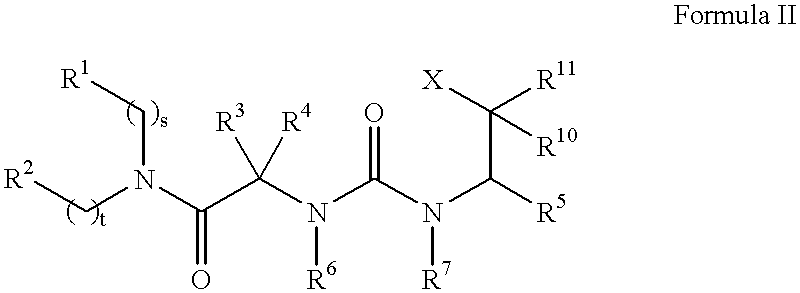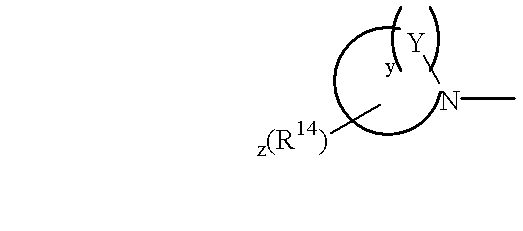N, N-disubstituted amides that inhibit the binding of integrins to their receptors
a technology of n-disubstituted amides and integrins, which is applied in the direction of drug compositions, immunological disorders, metabolism disorders, etc., and can solve problems such as wide-spread tissue damag
- Summary
- Abstract
- Description
- Claims
- Application Information
AI Technical Summary
Benefits of technology
Problems solved by technology
Method used
Image
Examples
example 1
Synthesis of (9S,13S)-13-(1,3-benzodioxol-5-yl)-9-{[benzyl(2-thienylmethyl) amino]carbonyl}-3,11-dioxo-1-phenyl-2-oxa-4,10,12-triazapentadecan-15-oic acid (6)
Step One: Thiophene 2-methylamine (1.36 ml, 13.26 mmol) was dissolved in methanol (20 ml). To this solution was added benzaldehyde (1.34 ml, 13.26 mmol), sodium cyanoborohydride (832 mg, 13.26 mmol) and 2 drops of acetic acid. The reaction was stirred at room temperature for 24 hours. The mixture was concentrated under reduced pressure and then taken up in ethyl acetate (500 ml). The organic layer was washed with water (200 ml), saturated NaHCO.sub.3 (200 ml) and brine (200 ml). The organic solution was dried over MgSO.sub.4 and then concentrated under reduced pressure. The residue was flushed through silica gel with ethyl acetate:hexane (1:3) which yielded 1 (1.305 g, 48%).
Step Two: Compound 1 (50 mg, 0.246 mmol) and N.alpha.-t-BOC-N.epsilon.-Cbz-L-lysine (94 mg, 0.246 mmol) were dissolved in DMF (3 ml), 1,3-dicyclohexylcarbod...
example 2
Synthesis of 3-({[((1S)-1-{[benzyl(2-thienylmethyl)amino]carbonyl}pentyl)amino]carbonyl }amino)-3-(4-butoxyphenyl)propanoic acid (12)
Step One: (1S, 2R, 5S)-(+)-Menthyl (R)-p-toluenesulfinate (0.59 g, 2.0 mmol) was dissolved in THF (5 mL) and chilled to -78.degree. C. under nitrogen. The mixture was treated with lithium N, N-bis(trimethylsilyl)amide (3.0 mL, 1.0 M in THF) via dropwise addition. Upon completion, the cold bath was removed and the mixture was stirred at room temperature for 5 hours. The solution was chilled to 0.degree. C. and thiophene-2-carboxaldehyde (0.37 mL, 4.0 mmol) was added, via syringe followed immediately with powdered cesium fluoride (0.61 g, 4.0 mmol). The resulting suspension was stirred at room temperature for 18 hours. The reaction was quenched with saturated, aqueous ammonium chloride and extracted with ethyl acetate. The organic phase was washed with brine and dried over Na.sub.2 SO.sub.4. The organic solution was filtered and concentrated under reduce...
example 3
Synthesis of (3S)-3-({[((1S)-1-{[bis(2-thienylmethyl)amino]carbonyl}pentyl) amino]-carbonyl}amino)-3-(2-methyl-1,3-thiazol-4-yl)propanoic acid, sodium salt (19).
Step One: To a solution of N-t-Boc-aspartic acid .beta.-methyl ester (6.0 g, 24.2 mmol) in dry THF (30 mL) was added triethylamine (5.2 mL, 36.4 mmol). The reaction mixture was cooled to 0.degree. C., treated with isobutylchloroformate (3.6 g, 26.2 mmol), and then stirred at 0.degree. C. for 1 hour. The ice-cold solution was filtered and then treated with a solution of diazomethane (100 mmol) in ether (75 ml). After stirring at low temperature for 1 hour, nitrogen gas was bubbled into the reaction to remove the excess diazomethane. Concentration gave 13 (4.5 g), which was used without further purification.
Step Two: Diazoketone 13 (4 g, 14.7 mmol) was dissolved in ether (20 mL). The reaction mixture was cooled to -30.degree. C., and then treated with 48% HBr in H.sub.2 O (5 mL). When a persistent yellow color formed the mixtu...
PUM
| Property | Measurement | Unit |
|---|---|---|
| temperature | aaaaa | aaaaa |
| temperature | aaaaa | aaaaa |
| temperature | aaaaa | aaaaa |
Abstract
Description
Claims
Application Information
 Login to View More
Login to View More - R&D
- Intellectual Property
- Life Sciences
- Materials
- Tech Scout
- Unparalleled Data Quality
- Higher Quality Content
- 60% Fewer Hallucinations
Browse by: Latest US Patents, China's latest patents, Technical Efficacy Thesaurus, Application Domain, Technology Topic, Popular Technical Reports.
© 2025 PatSnap. All rights reserved.Legal|Privacy policy|Modern Slavery Act Transparency Statement|Sitemap|About US| Contact US: help@patsnap.com



